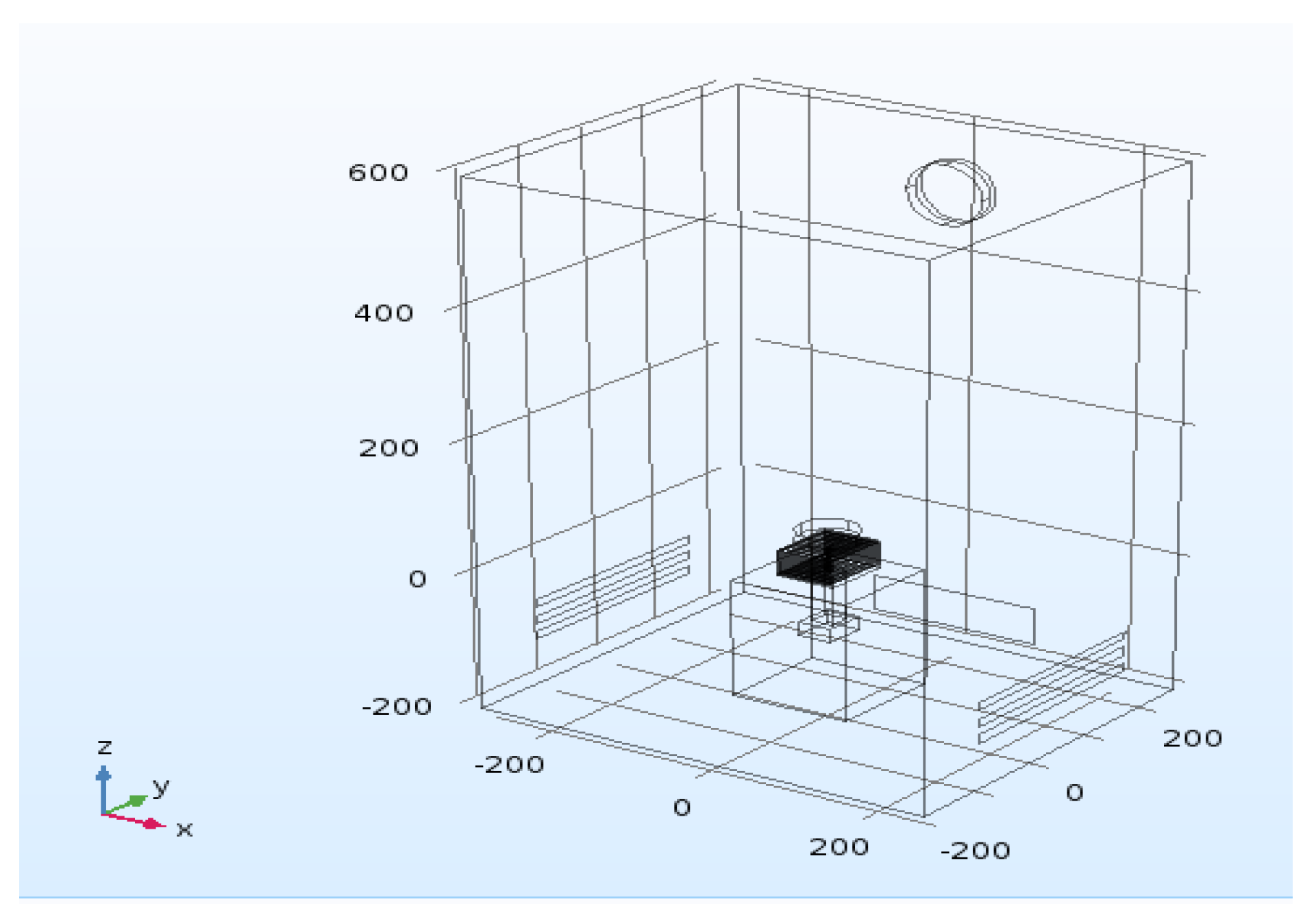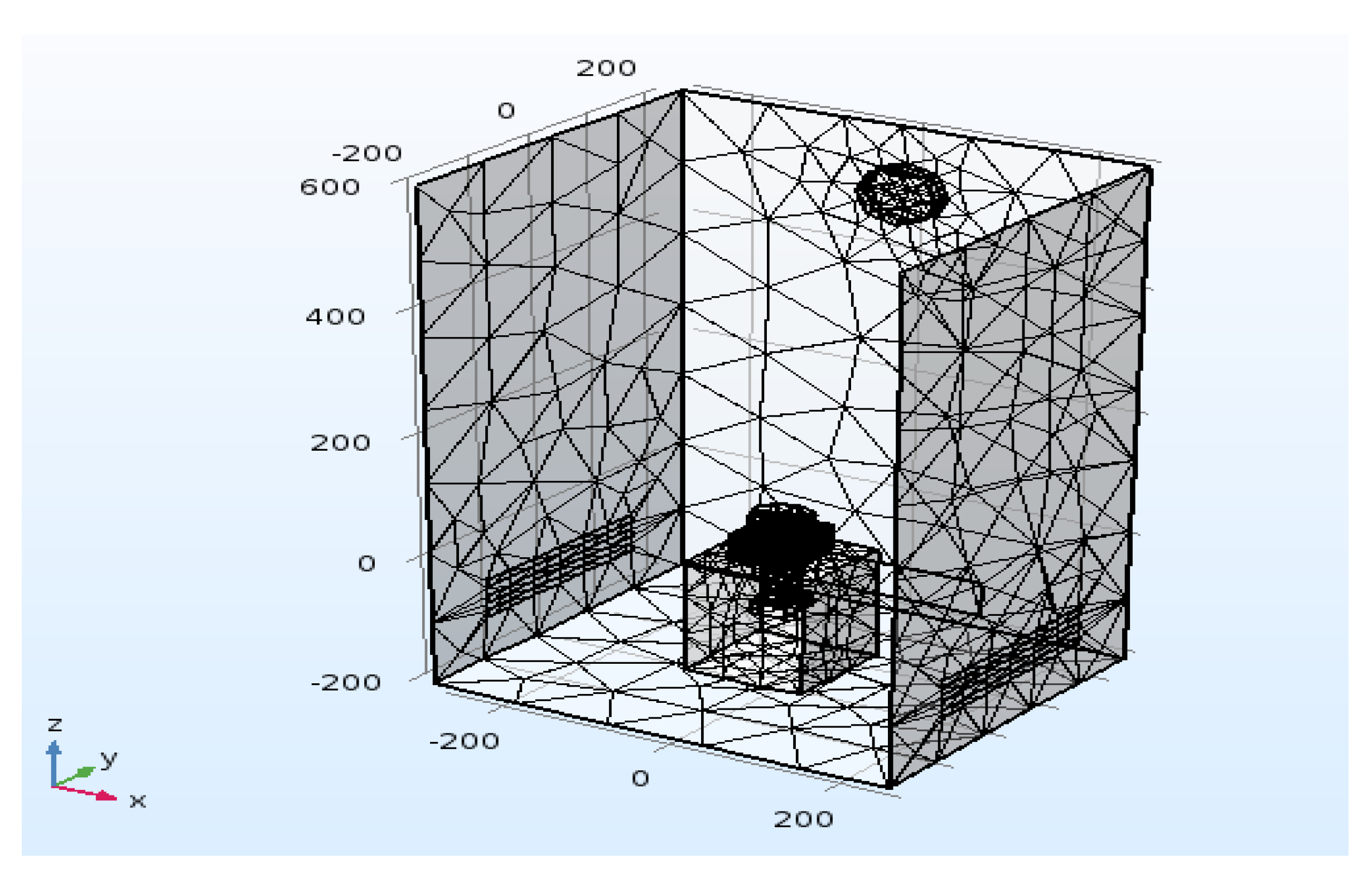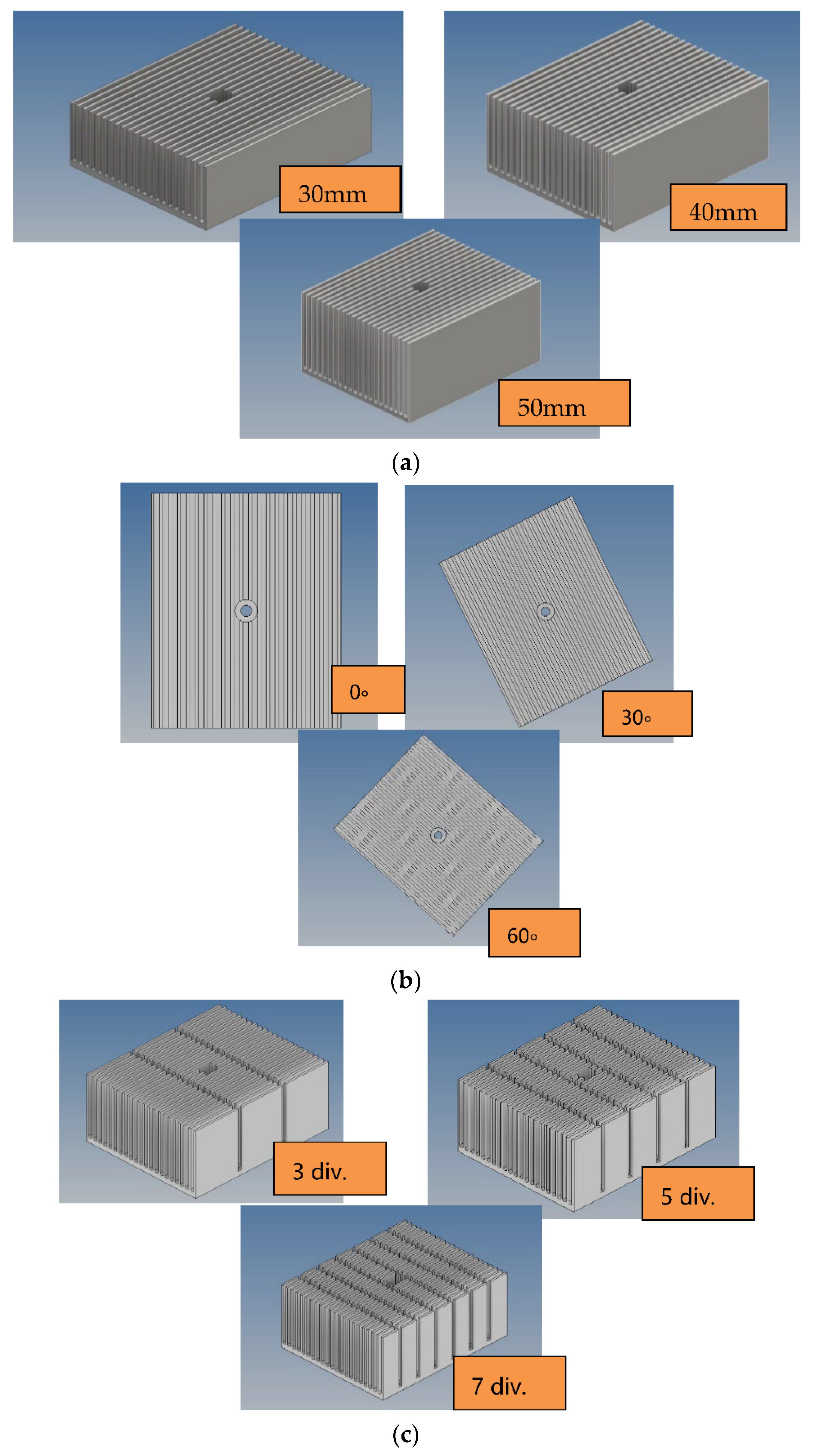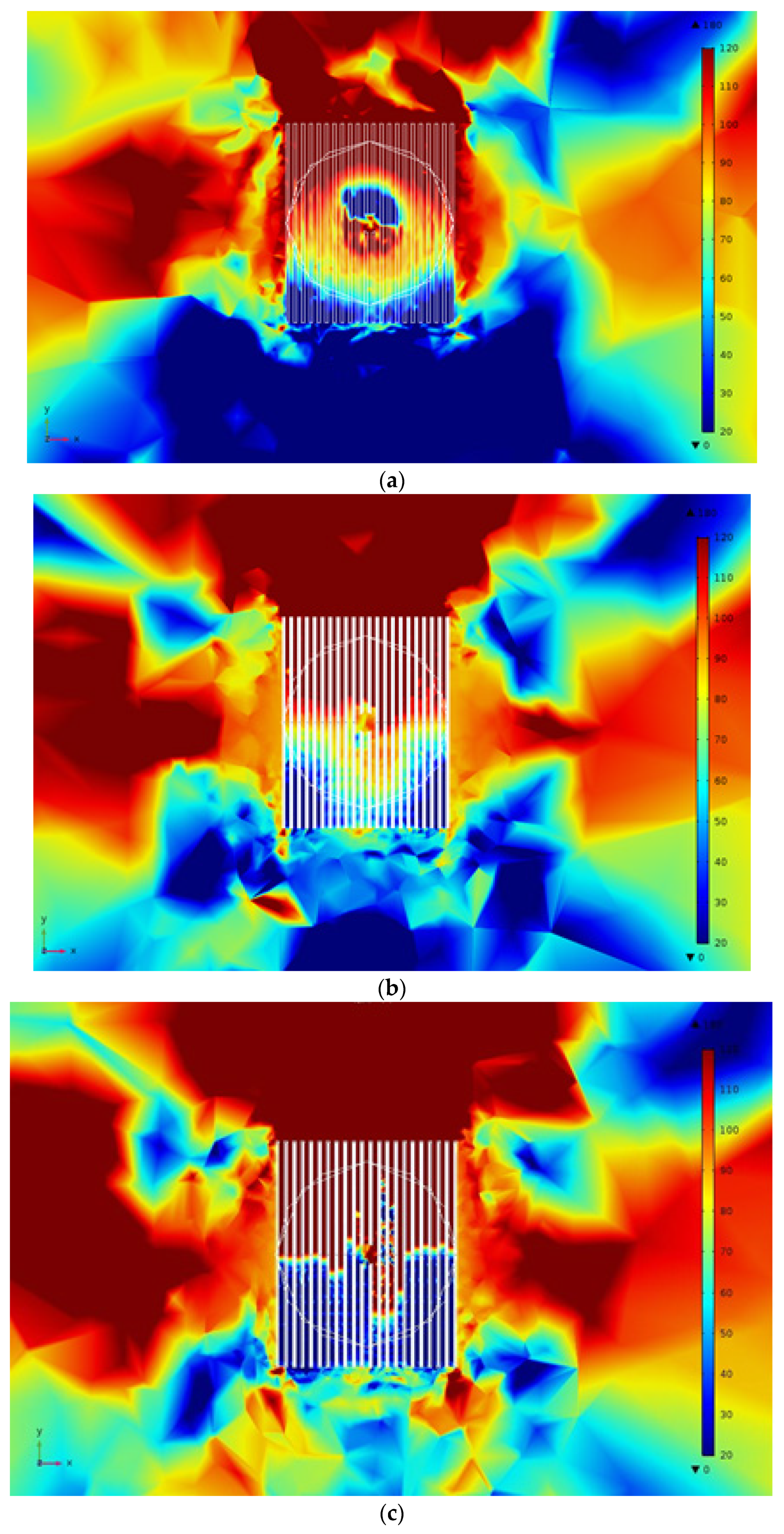Design Analysis of Heat Sink Using the Field Synergy Principle and Multitarget Response Surface Methodology
Abstract
:1. Introduction
2. Methodology
2.1. Field Synergy Principle (FSP)
2.2. Response Surface Methodology
3. Design Analysis
3.1. Heat Sink Model
- There will be a steady-state heat transfer.
- The fluid in the chamber is three-dimensional forced convection.
- The working fluid has an incompressible density.
- The model space’s walls are all nonslip surfaces.
- There is little radiation impact.
3.2. Boundary Conditions
3.3. Experiment Measuring
- (A)
- Measuring range: −40 °C to 500 °C
- (B)
- Resolution: 0.06 °C
- (C)
- Accuracy: ±2 °C or ±2% of reading, whichever was greater
- (A)
- Measuring range: 2~30 m/s
- (B)
- Resolution: 0.1 m/s
- (C)
- Accuracy: 2–10 m/s (±3% ± 0.5); 10–30 m/s (±3% ± 0.8)
3.4. Results and Discussion
B − 0.0212188A × C + 0.00760208B × C
4. Conclusions
- We investigated the effects of wall velocity on heat transport due to the field synergy angle. The effectiveness of heat dissipation increased with the synchromesh of the display field.
- The gradient and velocity field changes were not coordinated, which prevented the velocity field change from keeping up with the temperature difference between the fins. This resulted in a higher field synergy angle of the fins in the second half.
- When the synergy angle was employed to show the fins’ effects in heat transfer, the research findings supported the design combination. It is important to show the effectiveness of the heat-dissipation effect.
Author Contributions
Funding
Informed Consent Statement
Data Availability Statement
Conflicts of Interest
Nomenclature
| cp | Heat capacity, J/(kg∙K) |
| h | Heat transfer coefficient, W/(m2∙K) |
| k | Thermal conductivity, W/(m∙K) |
| l | Length, m |
| Nu | Nusselt number, dimensionless |
| Pr | Prandtl number, dimensionless |
| Q | Conduction heat source, W/m2 |
| Re | Reynold’s number, dimensionless |
| t | Time, s |
| T | Temperature, K |
| U | Fluid velocity field, m/s. |
| Mean velocity vector, m/s. | |
| u | Velocity in the x direction, m/s. |
| v | Velocity in the y direction, m/s. |
| w | Velocity in the z direction, m/s. |
| x | Spatial coordinate |
| Xi | Input factor |
| y | Spatial coordinate |
| yi | Output value |
| Y | Reaction variables |
| z | Spatial coordinate |
| Greek symbols | |
| Velocity boundary layer thickness, m | |
| Temperature boundary layer thickness, m | |
| Fluid density, kg/m3 | |
| μ | Dynamic viscosity, Pa/s |
| ν | Kinematic viscosity, m2/s |
| Field synergistic angle | |
| ▽T | Temperature gradient vector, K |
| ij | Coefficient of the linear and quadratic terms |
References
- Wang, P.; Cui, X.; Weng, J.; Cai, Z.; Cai, R. Experimental investigation of the heat transfer performance of an oscillating heat pipe with LiCl salt solution. Int. J. Heat Mass Transf. 2020, 158, 120033. [Google Scholar] [CrossRef]
- Ji, X.; Yang, X.; Zhang, Y.; Zhang, Y.; Wei, J. Experimental study of ultralow flow resistance fractal microchannel heat sinks for electronics cooling. Int. J. Therm. Sci. 2022, 179, 107723. [Google Scholar] [CrossRef]
- See, Y.; Ho, J.; Leong, K.; Wong, T. Experimental investigation of a topology-optimized phase change heat sink optimized for natural convection. Appl. Energy 2022, 314, 118984. [Google Scholar] [CrossRef]
- Shaeri, M.R.; Sarabi, S.; Randriambololona, A.M.; Shadlo, A. Machine learning-based optimization of air-cooled heat sinks. Therm. Sci. Eng. Prog. 2022, 34, 101398. [Google Scholar] [CrossRef]
- Muneeshwaran, M.; Lee, Y.-J.; Wang, C.-C. Performance improvement of heat sink with vapor chamber base and heat pipe. Appl. Therm. Eng. 2022, 215, 118932. [Google Scholar] [CrossRef]
- Leonardo, M.; Tapas, K.M.; Reddy, K.S. General correlations among geometry, orientation and thermal performance of natural convective micro-finned heat sinks. Int. J. Heat Mass Trans. Sci. Direct. 2015, 91, 711–724. [Google Scholar]
- Bergles, A.E. Heat Transfer Enhancement—The Maturing of Second-Generation Heat Transfer Technology. Heat Transf. Eng. 1997, 18, 47–55. [Google Scholar] [CrossRef]
- Bergles, A.E. Techniques to Enhance Heat Transfer. In Handbook of Heat Transfer, 3rd ed.; Rohsenow, W.M., Hartentt, J.P., Cho, Y.I., Eds.; McGraw-Hill: New York, NY, USA, 1998. [Google Scholar]
- Bergles, A.E. Enhanced Heat Transfer: Endless Frontier, or Maarmature Routine. Enhanced Heat Transfer. 1999, 6, 79–88. [Google Scholar] [CrossRef]
- Guo, Z.Y.; Li, D.Y.; Wang, B.X. A novel concept for convective heat transfer enhancement. Int. J. Heat Mass Transf. 1998, 41, 2221–2225. [Google Scholar] [CrossRef]
- Wang, S.; Li, Z.X.; Guo, Z.Y. Novel concept and device of heat transfer augmentation. In Proceedings of the Eleventh International Conference on Heat Transfer, Kyongju, Korea, 1 November 1998; pp. 405–408. [Google Scholar]
- Li, X.; He, Y.-L.; Tao, W.-Q. Analysis and extension of field synergy principle (FSP) for compressible boundary-layer heat transfer. Int. J. Heat Mass Transf. 2015, 84, 1061–1069. [Google Scholar] [CrossRef]
- Zhao, J.; Huang, S.; Gong, L.; Huang, Z. Numerical study and optimizing on micro square pin-fin heat sink for electronic cooling. Appl. Therm. Eng. 2016, 93, 1347–1359. [Google Scholar] [CrossRef]
- Zhanga, Y.; Liu, X. Application of Field Synergy Principle for Fin Reshaping of a Natural Convection Radiator. In Proceedings of the 9th International Symposium on Heating, Ventilation and Air Conditioning (ISHVAC) and the 3rd International Conference on Building Energy and Environment (COBEE), Tianjin, China, 12–15 July 2015; Volume 121, pp. 1726–1733. [Google Scholar]
- Yao, Y.; Weiwei, W.; Yang, K. Mechanism study on the enhancement of silica gel regeneration by power ultrasound with field synergy principle and mass diffusion theory. J. Heat Mass Transf. 2015, 90, 769–780. [Google Scholar] [CrossRef]
- Hamid, O.A.M.; Zhang, B.; Yang, L. Application of field synergy principle for optimization fluid flow and convective heat transfer in a tube bundle of a pre-heater. Energy 2014, 76, 241–253. [Google Scholar] [CrossRef]
- Ou, J.-J.; Li, L.-F.; Cui, T.; Chen, Z.-M. Application of field synergy principle to analysis of flow field in underhood of LPG bus. Comput. Fluids 2014, 103, 186–192. [Google Scholar] [CrossRef]
- Kundu, B.; Yook, S.J. An accurate approach for thermal analysis of porous longitudinal, spine and radial fins with all nonlinearity effects–analytical and unified assessment. Appl. Math. Comput. 2021, 402, 126124. [Google Scholar] [CrossRef]
- Wankhade, P.A.; Kundu, B.; Das, R. Establishment of non-Fourier heat conduction model for an accurate transient thermal response in wet fins. Int. J. Heat Mass Transf. 2018, 126, 911–923. [Google Scholar] [CrossRef]
- Das, R.; Kundu, B. Forward and Inverse Analyses of Two-Dimensional Eccentric Annular Fins for Space-Restriction Circumstances. J. Thermophys. Heat Transf. 2021, 35, 80–91. [Google Scholar] [CrossRef]
- Kundu, B. Exact Method for Annular Disc Fins with Heat Generation and Nonlinear Heating. J. Thermophys. Heat Transf. 2017, 31, 337–345. [Google Scholar] [CrossRef]
- Liu, C.; Yang, H. Multi-objective optimization of a concrete thermal energy storage system based on response surface methodology. Appl. Therm. Eng. 2021, 202, 117847. [Google Scholar] [CrossRef]
- Mohammed, B.S.; Khed, V.C.; Nuruddin, M.F. Rubbercrete mixture optimization using response surface methodology. J. Clean. Prod. 2018, 171, 1605–1621. [Google Scholar] [CrossRef]
- Mohammed, B.S.; Fang, O.C.; Anwar, H.; Lachemi, M. Mix proportioning of concrete containing paper mill residuals using response surface methodology. Construct. Build. Mater. 2012, 35, 63–68. [Google Scholar] [CrossRef]
- Abdulkadir, I.; Mohammed, B.S.; Liew, M.; Wahab, M. Modelling and multi-objective optimization of the fresh and mechanical properties of self-compacting high volume fly ash ECC (HVFA-ECC) using response surface methodology (RSM). Case Stud. Constr. Mater. 2021, 14, e00525. [Google Scholar] [CrossRef]
- Lin, M.-C.; Lin, R.-F. Innovative design for an active uniform heat dissipation system. Results Phys. 2020, 19, 103355. [Google Scholar] [CrossRef]






| 1. Material | ||
| Name | Material | Thermal conductivity [W/(m·K)] |
| Heat Sink | Aluminum 6063-T83 | 201 |
| Chamber | Acrylic plastic | 0.18 |
| Heat source | Al2O3-Aluminum oxide | 30 |
| Thermal insulation coating material | Owens–Corning fiberglass | 0.018 |
| Heat sticks | Red copper | 385 |
| Fluid | Air | 0.026 |
| 2. Turbulence mode: k-ω | ||
| Condition attribute | Parameter | Position |
| k-ω | Incompressible flow | Inside the entire chamber |
| Wall | Wall function (no slippage) | Except for entrance, exit, fan |
| Entrance | 1 m/s | Wall rear |
| Export | 1 atm | Wall |
| Fan 1 | PQ curve | Above the fin |
| Fan 2 | PQ curve | Chamber fan |
| 3. Heat transfer mode | ||
| Condition attribute | Parameter | Position |
| Heat transfer | Ambient temperature: 25 °C | The whole chamber |
| Solid heat transfer | Depending on the material type | Fins, fans, thermal insulation, shells |
| Fluid heat transfer | Air | Inside the chamber |
| Initial value | 25 °C | Overall |
| Heat source | 80 W | Heat source |
| Thin layer | Heat paste: Layer thickness: 50 μm With ST-350 | Between the fins and the thermal bars |
| Temperature | Entry temperature: 25 °C | Chamber rear |
| Outflow | Export | Fan and drain on both sides |
| Node number | 20743 |
| Tetrahedron elements number | 122097 |
| Triangle elements number | 34126 |
| Minimum element quality | 0.005516 |
| Average element quality | 0.5344 |
| Element volume ratio | 9.048 × 10−8 |
| Mesh volume | 1.944 × 108 |
| Item | A Fin Height (mm) | B Heat Sink Angle (Degree) | C Fin Aliquots | Field Synergy Angle (Y1) | Fin Average Temperature (°C) (Y2) |
|---|---|---|---|---|---|
| 1 | 30 | 0 | 3 | 90.605 | 67.715 |
| 2 | 40 | 30 | 3 | 90.089 | 59.309 |
| 3 | 40 | 30 | 5 | 87.953 | 59.793 |
| 4 | 30 | 30 | 5 | 87.953 | 59.793 |
| 5 | 50 | 30 | 5 | 87.953 | 59.793 |
| 6 | 30 | 0 | 7 | 91.303 | 68.211 |
| 7 | 40 | 0 | 5 | 92.779 | 58.428 |
| 8 | 50 | 60 | 3 | 87.007 | 54.403 |
| 9 | 50 | 0 | 3 | 93.409 | 51.529 |
| 10 | 40 | 30 | 5 | 87.953 | 59.793 |
| 11 | 50 | 0 | 7 | 92.568 | 57.225 |
| 12 | 40 | 30 | 7 | 89.076 | 63.077 |
| 13 | 40 | 30 | 5 | 87.953 | 59.793 |
| 14 | 30 | 60 | 7 | 88.778 | 67.924 |
| 15 | 50 | 60 | 7 | 87.832 | 58.260 |
| 16 | 40 | 30 | 5 | 87.953 | 59.793 |
| 17 | 40 | 30 | 5 | 87.953 | 59.793 |
| 18 | 40 | 30 | 5 | 87.953 | 59.793 |
| 19 | 40 | 60 | 5 | 85.823 | 59.320 |
| 20 | 30 | 60 | 3 | 86.097 | 65.586 |
| Response Surface Regression: Y1 versus A, B, C Estimated Regression Coefficients for Y1 | ||
|---|---|---|
| Term | Coefficient | p value |
| A | 88.1320 | 0 |
| B | 0.4033 | 0.095 |
| C | −2.5127 | 0 |
| A × A | 0.2350 | 0.308 |
| B × B | −0.4475 | 0.309 |
| C × C | 0.9005 | 0.056 |
| A × B | 1.1820 | 0.018 |
| A × C | −0.5131 | 0.062 |
| B × C | −0.4244 | 0.113 |
| R-Sq(adj) = 89.69% | ||
| Response Surface Regression: Y2 versus A, B, C Estimated Regression Coefficients for Y2 | ||
|---|---|---|
| Term | Coefficient | p value |
| A | 4.08896 | 0 |
| B | −0.07892 | 0 |
| C | 0.00512 | 0.696 |
| A × A | 0.02773 | 0.054 |
| B × B | 0.00481 | 0.847 |
| C × C | −0.01071 | 0.668 |
| A × B | 0.02748 | 0.284 |
| A × C | 0.01355 | 0.364 |
| B × C | 0.01638 | 0.277 |
| R-Sq(adj) = 66.99% | ||
| Item | Fin Height | Heat Sink Angle | Fin Aliquots | Fin’s Bottom Field Synergy | Fin’s Middle Field Synergy | Fin’s Top Field Synergy |
|---|---|---|---|---|---|---|
| Best combination | 50 mm | 60° | 5 | 53.476 | 73.581 | 42.039 |
Publisher’s Note: MDPI stays neutral with regard to jurisdictional claims in published maps and institutional affiliations. |
© 2022 by the authors. Licensee MDPI, Basel, Switzerland. This article is an open access article distributed under the terms and conditions of the Creative Commons Attribution (CC BY) license (https://creativecommons.org/licenses/by/4.0/).
Share and Cite
Lin, M.-C.; Lin, R.-F. Design Analysis of Heat Sink Using the Field Synergy Principle and Multitarget Response Surface Methodology. Energies 2022, 15, 8399. https://doi.org/10.3390/en15228399
Lin M-C, Lin R-F. Design Analysis of Heat Sink Using the Field Synergy Principle and Multitarget Response Surface Methodology. Energies. 2022; 15(22):8399. https://doi.org/10.3390/en15228399
Chicago/Turabian StyleLin, Ming-Che, and Ruei-Fong Lin. 2022. "Design Analysis of Heat Sink Using the Field Synergy Principle and Multitarget Response Surface Methodology" Energies 15, no. 22: 8399. https://doi.org/10.3390/en15228399
APA StyleLin, M.-C., & Lin, R.-F. (2022). Design Analysis of Heat Sink Using the Field Synergy Principle and Multitarget Response Surface Methodology. Energies, 15(22), 8399. https://doi.org/10.3390/en15228399






